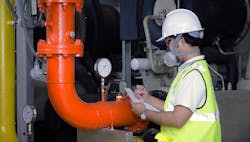Only twenty critical vessels had been on the plant’s pressure vessel list. Yet, I found the site contained about 400 pressure vessels (see addendum for a simple guide to pressure vessels and tanks). When asked why I included coils and filters on my list, I stressed that they’re under pressure and tend to incur maintenance problems.
The two key questions about inspections are what to check and how often?
Put on your list any vessel with a pressure >15 psig or with a vacuum rating. This includes pipe in a coil (even it falls under ANSI standards) and most filters because they rely on pressure to move the fluid through. You generally can exclude equipment suction filters unless vacuum is possible.
Besides pressure, always consider corrosion. Corrosive service tends to significantly shorten equipment life.
[pullquote]
Other items also should undergo periodic inspection. These include pressure relief devices, atmospheric and low-pressure tanks, pipe and even instruments and electrical systems such as motor control centers. And don’t forget to check structural steel and sewers on a regular cycle.
Let’s consider pressure relief systems. The usual practice is to periodically replace rupture discs and pop (test) relief valves. Inspect valves in critical services like chlorine operations, where risk is high and potential loss is extreme, at least once a year or more if warranted. Refineries generally swap out devices every three years even though API-576 and API-510 allow five years. Many plants will extend the replacement period after two or three cycles of reliable service — if operations keep up rigorous routine inspections; monthly generally is recommended. This often is the case for water thermal expansion valves on heat exchangers.
As far as coils, for some reason, they are covered under external inspection of atmospheric tanks. The edition of API-575 I have — the first, 1995, version, then called “Inspection of Atmospheric and Low-Pressure Storage Tanks,” outlines coil inspection in sections 8.2.8.4 and 8.4.9. It refers the reader to API-653, section 6.3.3.2, which recommends a 5-yr inspection with thickness measurement for tanks in new service (application). Ultrasonic testing (UT) suits carbon steel and many alloys but may not be accurate for some alloys like those of nickel where corrosion is interstitial.
For well-known corrosion conditions, don’t exceed a 5-yr inspection frequency for a new tank. Otherwise, set inspection interval based on the measured (averaged or general) corrosion rate: (tmeasured – tminimum)/2N, where t is thickness and N is the corrosion rate/year measured (or anticipated based on past experience), usually given in mils. API establishes 15 years as a maximum interval for external inspection of atmospheric tanks and, by default, coils. Out-of-service tanks only require external inspection (6.3.3.3) based on corrosion rate.
For atmospheric tanks, base internal inspection frequency on the corrosion measurements of the bottom plate and containment; see API-653, Table 6-1. Internal inspections for new service should occur in ten years or sooner: corrosion rates set the frequency from there. For known applications, you can establish inspection frequency by experience. Twenty years is the maximum allowable frequency based on API-653. (Use API-653, not API-510, for low-pressure vessels.)
Conduct an external inspection of a pressure vessel every five years. An internal inspection must take place at an interval no more than half the estimated remaining life of the vessel or ten years (maximum) unless the vessel life is less than four years (API-510, section 6.4). Use the measurement method above to predict life. So, if a vessel’s life is eight years, the frequency is four years, not ten. Then, after four years, the time between internal inspections drops to the remaining life or two years — maximum.
This method is the simplest one. It is based on a predictable failure or localized corrosion. A more-sophisticated approach is onstream inspection, i.e., checking operating equipment, using non-destructive evaluation. However, local regulators and inspectors familiar with the vessel exposure must approve the approach. The advantages of onstream inspection are obvious: no need for vessel cleaning and improved safety for the inspectors.
An alternative basis has been proposed in API-575 and API-510 for atmospheric and pressure vessels, respectively. That approach, called a risk-based inspection assessment, focuses on the likely failure scenario rather than relying on undefined causes resulting in a loss of thickness.
Inspection is a complicated topic. However, safe operation of a chemical facility requires regularly checking all at-risk equipment and using appropriate intervals.
DIRK WILLARD is a Chemical Processing Contributing Editor. You can email him at [email protected]
About the Author

Dirk Willard
Contributing Editor
DIRK WILLARD is a former ASBPE award-winning columnist for Chemical Processing's Field Notes column. During his 10+ years as a contributing editor for CP, he wrote hundreds of valuable and insightful pieces on design and operational issues. He retired in 2023.
